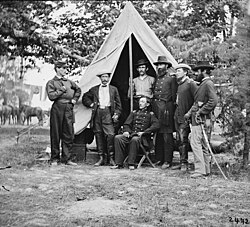| 3rd Indiana Cavalry Regiment 45th Indiana Infantry Regiment | |
|---|---|
 A detachment of 3rd Indiana Cavalry Regiment in Petersburg, Virginia. | |
| Active | August 22, 1861 - August 7, 1865 |
| Engagements | American Civil War |
| Commanders | |
| Notable commanders | |
| Indiana U.S. Volunteer Cavalry Regiments 1861-1865 | ||||
|
The 3rd Indiana Cavalry Regiment, also designated the 45th Indiana Infantry Regiment or the 45th Indiana Volunteers was a military unit from the U.S. state of Indiana that participated in the American Civil War. It consisted of two separate "wings" or battalions that were separated for much of the regiments service.[1]

The 3rd Indiana Cavalry Regiment "East Wing" or "Right Wing" consisted of Companies A, B, C, D, E, and F, which were organized at Madison, Indiana on August 22, 1861, that were intended for service with the 1st Indiana Cavalry Regiment. On October 22, 1861, the six companies were designated as part of the 3rd Indiana Cavalry Regiment and assigned to the Army of the Potomac in the Eastern Theater of the war. The East Wing saw action at the Battle of Antietam and fought with distinction at the Battle of Gettysburg, where in the opening day's action on July 1, 1863, the unit held off far larger Confederate forces until the main Union force arrived.[1][2][3]
The 3rd Indiana Cavalry Regiment "West Wing" or "Left Wing" consisted of Companies G, H, I, K, L and M. The first four companies were organized at Madison, Indiana on October 1, 1861. In December, 1861 the companies were assigned to the Army of the Ohio. Company L was organized in October 1862, and Company M, organized in December 1862, both companies L and M later joined the unit in Eastern Tennessee. The West Wing saw action at the Battle of Chickamauga. In December 1864, the West Wing companies were transferred to the 8th Indiana Cavalry Regiment.[1][2][3]
| Company | Primary Place of Recruitment | Earliest Captain |
|---|---|---|
| A | Switzerland County | Jacob S. Buchanan |
| B | Harrison County | James D. Irvin |
| C | Switzerland County | Theophilus M. Danglade |
| D | Dearborn County | Daniel B. Keister |
| E | Jefferson County | William Simrall McClure |
| F | Union County | Patrick Carland |
| G | Johnson County | Felix W. Graham |
| H | Clinton County | Alfred Gaddis |
| I | Henry County | Will C. Moreau |
| K | Switzerland County | Robert Klein |
| L | No cities or counties given | Oliver M. Powers |
| M | No cities or counties given | Charles U. Patton |


A memorial for the 3rd Indiana Cavalry Regiment stands at the Gettysburg Battlefield at North Reynolds Avenue.